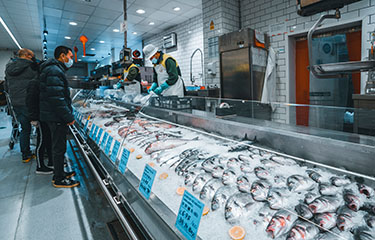UK seafood inflation likely to continue climbing this year, prices rising rapidly

U.K. food prices are rising at the fastest rate in over 40 years, according to new data from the U.K. Office for National Statistics.
Grocery price inflation rose again in February, reaching 17.1 percent in the four weeks to 19 February, the highest level ever recorded by research firm Kantar. As a result, overall take-home grocery sales by value increased by 8.8 percent during the four weeks and by 8.1 percent for the most-recent quarter.
While overall grocery sales increased, chilled and frozen seafood sales continued to decline. Only ambient seafood sales grew, according to Seafish, the public body that supports the U.K. seafood industry.
The impact is being felt across retail seafood sales, as grocery inflation broke another U.K. record in February. Analysts expect seafood price inflation to continue rising in 2023, but noted a few standout seafood items likely to perform well.
“2022 was a tough year for seafood, with the category returning to accelerated decline. Both the value and volume of seafood sales continued to fall through the fourth quarter,” Seafish Market Insight Analyst Richard Watson told SeafoodSource. Overall seafood sales – chilled, frozen, and ambient – dropped 3.6 percent for the year to GBP 4.06 billion (USD 4.9 billion, EUR 4.6 billion), while volume fell 5.5 percent.
In response to the ongoing inflation crisis, some U.K. retailers are making drastic moves. Tesco will eliminate around 1,750 lead and team managers in its large stores, but said it will add around 1,800 positions in other stores. After closing meat, seafood, and hot deli counters in around 390 stores since 2019, Tesco is moving to close all its remaining counters starting in February.
“We have seen a significant decrease in demand for our counters over the last few years, and our customers no longer say they are a significant reason for them to come in store and shop with us. Instead, they are choosing to buy from our wide range of great quality products available in our aisles,” Tesco said.
The current rate of decline in seafood sales is concerning because seafood realized only relatively modest inflation of 1.2 percent compared to other food items in 2022 through September, according to Watson.
"But inflation is now showing signs of increasing ... and is likely to continue to increase into 2023 – already at 5.6 percent in February 2023 – reflecting increased raw material and production costs,” he said. “Seafood already has a relatively high average price compared to other proteins, as a result of regular double-digit inflation over the past 15 years, so any further increase in prices will add to the negative impact on sales."
Pressure on the personal finances of U.K. resident continued to impact seals of nearly all seafood items in the second half of 2022, according to Watson. Only tuna, along with mixed seafood, sardines, crabstick, and hake grew volume sales,“ultimately benefiting from consumers’ turning to sandwiches to save money.”
Ambient seafood sales soared 10 percent in December 2022, according to Seafish.
“This is down to shoppers’ laser focus on price, and ambient being the cheapest sector. Essentially, shoppers trading down within seafood to save money have skipped frozen, turning straight into the cheapest seafood option,” Watson said.
As a result, sales of frozen seafood plummeted 10 percent in December, and chilled seafood sales volume also fell 8.4 percent in December, according to Seafish. This was likely due to chilled seafood having the highest average price of all three seafood sectors at GBP 14.20 (USD 17.07, EUR 16.07) per kilogram, up 5.2 percent month-over-month, according to Watson.
“This trend is likely to continue into 2023 until financial pressure and uncertainty eases,” Watson said.
The only chilled seafood product that experienced growth in December was ...
Photo courtesy of Octus_Photography/Shutterstock





Share